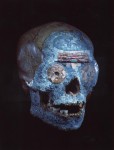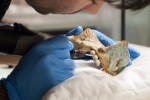 An ancient turquoise-encrusted skull acquired by the National Museum of Ethnology in Leiden, the Netherlands, back in 1963 has been discovered to be a forgery. It was believed to be a very rare skull made by the Mixtec people of Postclassic Mexico (1200-1600 A.D.) who were renown for their craftsmanship in metal and precious stones. They made skulls and masks inlaid with turquoise, pyrite, gold and obsidian. Only about 20 Mixtec skulls decorated with precious stones are known to exist, but they are all of questionable origin. Their find sites and finders are unknown.
An ancient turquoise-encrusted skull acquired by the National Museum of Ethnology in Leiden, the Netherlands, back in 1963 has been discovered to be a forgery. It was believed to be a very rare skull made by the Mixtec people of Postclassic Mexico (1200-1600 A.D.) who were renown for their craftsmanship in metal and precious stones. They made skulls and masks inlaid with turquoise, pyrite, gold and obsidian. Only about 20 Mixtec skulls decorated with precious stones are known to exist, but they are all of questionable origin. Their find sites and finders are unknown.
The National Museum of Ethnology bought theirs for the equivalent of about $20,000. Considered one of the greatest masterpieces of the genre, it is inlaid with small turquoise, shell and mother-of-pearl tiles all over the face, in circles around the eye sockets and larger rectangular tiles in the shape of a snake winding across the forehead. It was thought to date to around the 15th century.
 Research into its origins took a new turn in 2010 when conservator Martin Berger heard from a colleague in Marseille that a private collector had recently donated a similar skull with the caveat that he suspected it might be a forgery. Between 2012 and 2016, Berger took the skull to Paris and back to Leiden where he and his colleagues subjected it to extensive testing. Radiocarbon dating and stable isotope analysis of tooth enamel samples found that the skull’s geographic origin and age indicated it was authentic Mixtec. The turquoise was authentic archaeological stone as well.
Research into its origins took a new turn in 2010 when conservator Martin Berger heard from a colleague in Marseille that a private collector had recently donated a similar skull with the caveat that he suspected it might be a forgery. Between 2012 and 2016, Berger took the skull to Paris and back to Leiden where he and his colleagues subjected it to extensive testing. Radiocarbon dating and stable isotope analysis of tooth enamel samples found that the skull’s geographic origin and age indicated it was authentic Mixtec. The turquoise was authentic archaeological stone as well.
There was but one element left to test: the glue. The Mixtec made adhesives out of pine resin and orchids. Analysis of the glue used to affix the mosaic tiles to the skull discovered that it was a 20th century product commonly used in art restoration. That means someone in the 20th century took a genuine Mixtec skull and stuck genuine Mixtec mosaic tiles on it in a plausibly Mixtec style. So it’s a counterfeit made on an authentic foundation.
 Conservators believe they know who might have done the job. There was a Mexican dentist working in the 1940s and 50s who was known to dabble in recreations of Mesoamerican artwork. In the mid-century period, Mexico’s archaeological sites were extensively looted and it would have been difficult to scare up a genuine skull and a bunch of genuine tiles. Apparently this dentist’s work appeared in more than one museum. He’s a suspect in this case because there is evidence that some of the teeth on the skull have been tampered with, and that was obviously in his professional wheelwell.
Conservators believe they know who might have done the job. There was a Mexican dentist working in the 1940s and 50s who was known to dabble in recreations of Mesoamerican artwork. In the mid-century period, Mexico’s archaeological sites were extensively looted and it would have been difficult to scare up a genuine skull and a bunch of genuine tiles. Apparently this dentist’s work appeared in more than one museum. He’s a suspect in this case because there is evidence that some of the teeth on the skull have been tampered with, and that was obviously in his professional wheelwell.
The National Museum of Ethnology is keeping the skull on display.
Asked whether he was disappointed by the revelation, Berger told the newspaper: “No.”
“In actual fact it’s given us a bizarre story and that’s exactly what museums want to do, to tell stories. It remains as one of our masterpieces — except, we’ve changed the information on the sign board.”
In any case, said Berger, the skull is only a “partial forgery”.